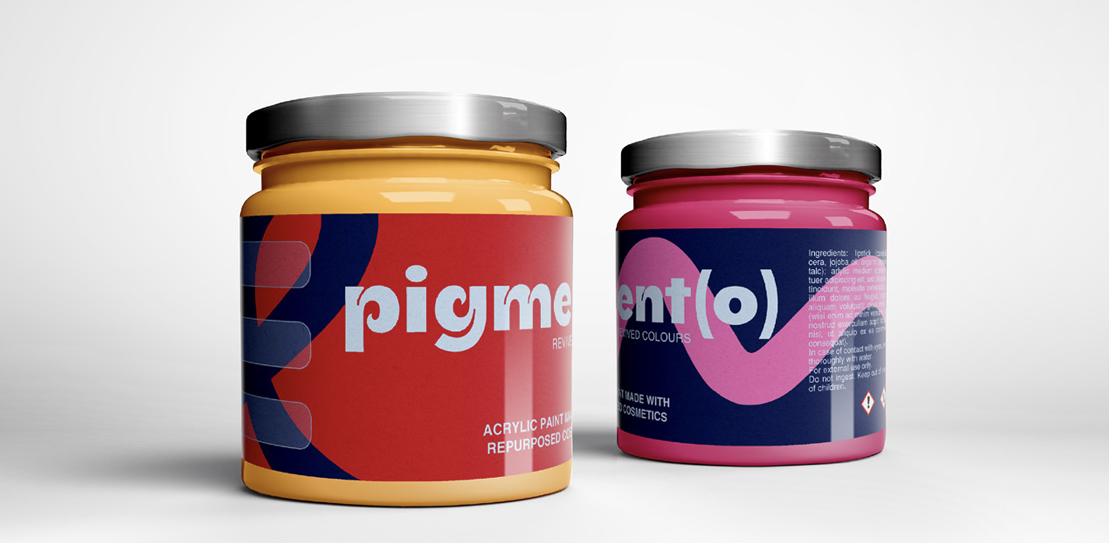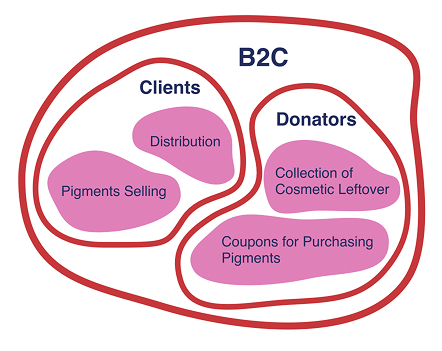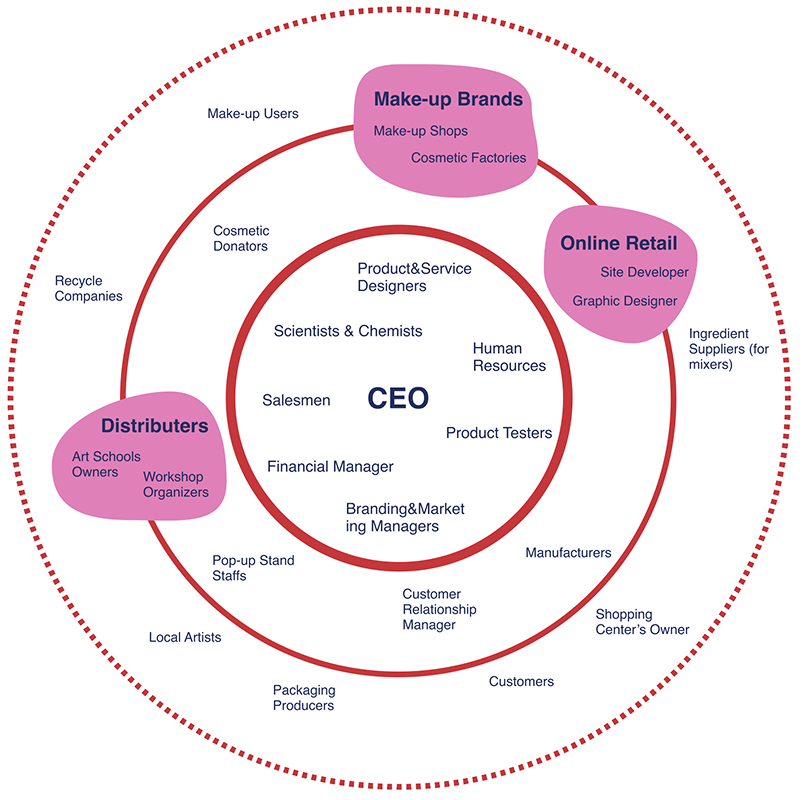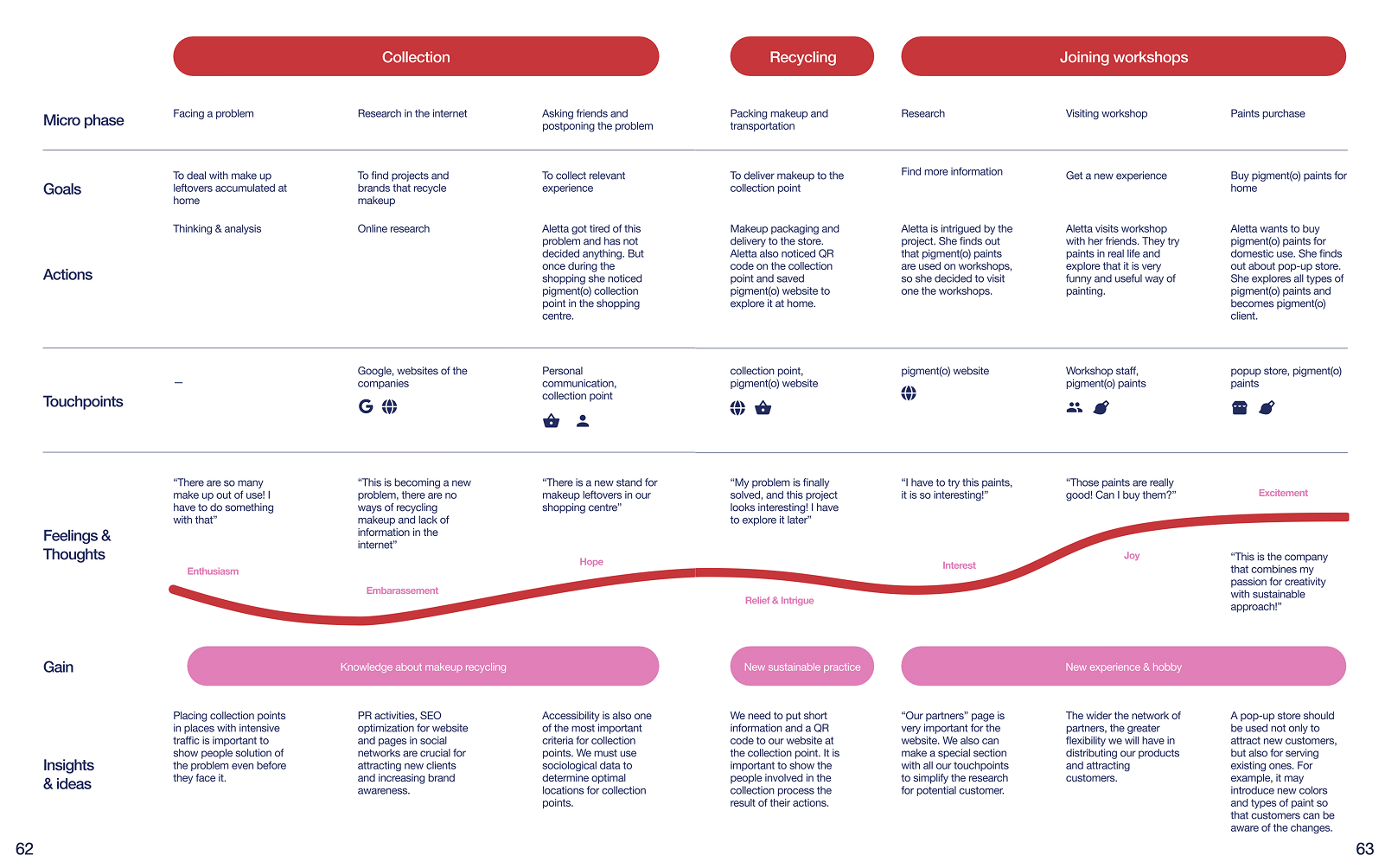Approach
The project was developed as part of the Product Service Design Studio at Politecnico di Milano. Our team of five students followed the Double Diamond framework: at the end of each stage, we arrived at a clearly defined idea and then continued to expand and refine it further.
.jpg)
Problem statement
The main problem our project addresses is cosmetic waste. Considering the scale of the beauty industry and the large amount of leftover products, this issue required a new and sustainable approach.
In Europe alone, consumers spent over 95.7 billion euros on cosmetics in 2023 (Europe: Cosmetics Consumption Value 2012–2023, Statista, 2024).
The global beauty market is expected to grow at an annual rate of 6% through 2028 (Weaver et al., 2024).
It is estimated that around 30% of beauty products go unused after purchase (Gutierrez, 2023).
Survey
The survey was conducted in December 2024 and received 74 responses. 91.9% of participants were between 18 and 35 years old, 5.4% were over 50, and 2.7% were under 18. The survey showed that the problem of cosmetic waste at the household level is relevant. It also confirmed our hypothesis that engaging in creative activities at home is a highly popular hobby among our target audience.


Solution
We conducted research and a survey to assess the relevance of the problem and the demand for potential solutions. Then, we carried out a series of experiments to define the paint’s composition and the optimal production method.
Finally, after developing several paint prototypes, we designed a complete product–service system, including stakeholders, material collection methods, and distribution channels.
Finally, after developing several paint prototypes, we designed a complete product–service system, including stakeholders, material collection methods, and distribution channels.
Product part
The concept behind Pigment(o) is to repurpose unused or expired makeup into paint products for both amateur and professional artists. While some initiatives already transform powdered makeup into watercolor or acrylic paint, this area remains largely untapped, with few brands exploring its full potential.
Calculations show that if 74% of adult women in Rotterdam returned their unused makeup, the collected materials could produce around 10,640 kilograms of usable paint — enough for nearly 89,000 individual packages. This demonstrates the strong potential for upcycling cosmetics into creative, sustainable products.

Collection points
Pigment(o) was planned to collaborate with both individuals and beauty retailers to collect unused, expired, or leftover makeup for repurposing. For the pilot phase in Rotterdam, two potential partners were identified — Etos and Douglas — representing different market segments: affordable and high-end beauty. Both brands would host in-store collection points and contribute their own unsold products to support the circular system.
Additionally, Pigment(o) was envisioned to operate its own pop-up store in Koopgoot, Rotterdam’s central shopping district, serving as both a collection hub and a showcase for the brand’s sustainable mission.
Additionally, Pigment(o) was envisioned to operate its own pop-up store in Koopgoot, Rotterdam’s central shopping district, serving as both a collection hub and a showcase for the brand’s sustainable mission.
Selling points
Pigment(o) distributes its paint through three main channels: workshops hosted by partner brands, where participants can purchase the paint after using it; a pop-up store in Rotterdam’s city center (Koopgoot); and an online shop available on the brand’s website.

Offering map
Pigment(o) offers a circular service engaging both individuals and businesses in sustainable practices. For consumers, makeup collection boxes in stores make it easy to donate unused cosmetics and receive discounts on recycled pigments, sold later through pop-ups.

On the B2B side, Pigment(o) partners with beauty retailers, shopping centers, and art institutions—handling collection logistics, providing materials for workshops, and promoting eco-conscious creativity across multiple touchpoints.

Stakeholder & system map
The stakeholder ecosystem of Pigment(o) is built around collaboration: the CEO coordinates internal teams, while partners like Douglas and Etos act as donors and collection points.
Distributors such as workshops connect the final products with customers, and recycling companies like Dar and Greencycle manage leftover materials. Local artists, schools, and workshop participants form the end-users, together creating a circular network that turns waste into value through cross-sector cooperation.
Distributors such as workshops connect the final products with customers, and recycling companies like Dar and Greencycle manage leftover materials. Local artists, schools, and workshop participants form the end-users, together creating a circular network that turns waste into value through cross-sector cooperation.


Exhibition
The project was presented at the "Disrupting orders" exhibition at the STECCA 3.0 space in Milan in January 2025.


Book
Credits
Team:
Maksim Lomaev
Leonora Melli
Francesco Renaldini
Camilla Boehm
Veerle Sonnemans
Xin Shen
Maksim Lomaev
Leonora Melli
Francesco Renaldini
Camilla Boehm
Veerle Sonnemans
Xin Shen
Politecnico di Milano
Product Service System Design Innovation Studio
A.Y. 2024/2025
Professors: Valentina Auricchio, Stefana Broadbent, Marta Corubolo, Fabio Di Liberto, Ilkka Suppanen
Assistants: Dorotea Anfossi, Nour Bergaoui
Product Service System Design Innovation Studio
A.Y. 2024/2025
Professors: Valentina Auricchio, Stefana Broadbent, Marta Corubolo, Fabio Di Liberto, Ilkka Suppanen
Assistants: Dorotea Anfossi, Nour Bergaoui




